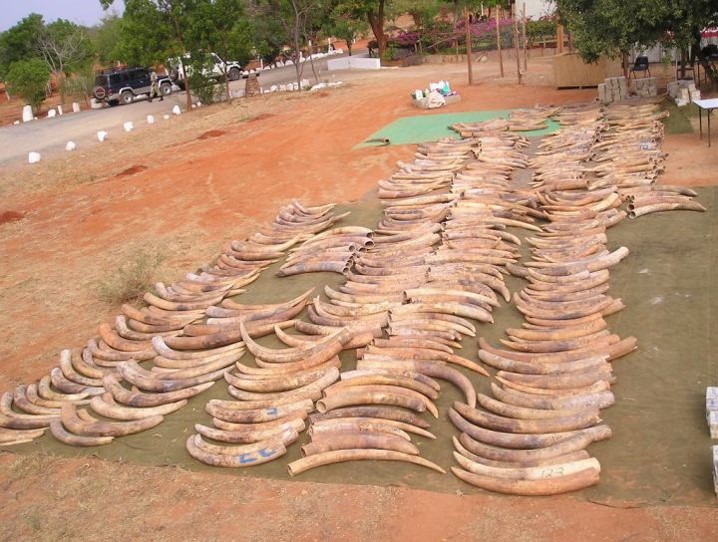Tusks in illegal seizures usually come from elephants killed within the last three years and rarely from old government or other stockpiles.
By Shreya Dasgupta
A seizure made in Malaysia in December 2012. (Photo: Syarifah Khadiejah Syed Mohd Kamil/Malaysia Department of Wildlife and National Parks)
The multi-billion-dollar illegal ivory trade is almost entirely being fueled by recently killed African elephants, a new study has found.
Tusks in illegal seizures usually come from elephants killed within the last three years, and rarely from old government or other stockpiles as has been previously suspected, researchers report in the study published in Proceedings of the National Academy of Sciences. This is the first study of its kind to assess the age distribution of large ivory seizures, researchers say.
“This is somewhat of a surprise,” Elizabeth Bennett, vice president for species conservation at the Wildlife Conservation Society who was not involved in the study, said in a statement. “This study shows that ivory once poached in Africa, is going very rapidly into the trade. This is all new ivory that is going into the illegal market. It is not old ivory from stockpiles that we thought were probably leaking into the market.”
To find out when elephants were killed for their tusks, researchers relied on a series of nuclear bomb tests conducted in the 1950s and ’60s that doubled the amount of the radioactive isotope carbon-14 in the atmosphere. Plants took in this isotope during photosynthesis, and animals — including elephants — that ate those plants ended up with the isotope in their tissues. By measuring the amount of left over carbon-14 isotope in the pulp cavity of tusks, researchers estimated the elephants’ time of death.
The researchers analyzed 231 tusks seized from 14 large seizures in nine countries between 2002 and 2014, and found that abut 90 percent of the ivory came from elephants that had been killed less than three years before the ivory was confiscated. In fact, some elephants were killed just a few months before their tusks were seized. Only one tusk belonged to an elephant killed 19 years before its ivory was seized.
“The overwhelming majority of the ivory we analyzed from 14 different seizures came from recently killed elephants,” says study co-author Kevin Uno, a geochemist at Columbia University’s Lamont-Doherty Earth Observatory. “This bolsters poaching estimates by eliminating the possibility of old, stockpiled ivory from artificially inflating the poaching estimates. It further highlights that African elephant are in real danger.”
The study also highlights some changing patterns of the ivory trade. Tusks in seizures have been getting progressively smaller, the researchers found, which they say could be because most of the really big elephants have already been killed.

An ivory seizure made in Singapore in 2002. (Photo: Benezeth Mutayoba/Sokoine University of Agriculture, Tanzania)
The time lag between poaching and seizures has also been increasing since 2011, the study found. Between 2002 and August 2010, the lag time ranged from seven to 13 months. But, since 2011, the lag time has increased to 13 to 32 months. The reason for this shift remains unclear, Uno says.
“The increased lag time may be reflecting a longer time period required to amass tusks for shipment because there are less elephants compared to a decade ago,” Uno says. “Or it may reflect the effectiveness of anti-poaching units in slowing down the poaching and trade networks, but poaching numbers are still unsustainably high. Finally, it could reflect a drop in the demand of ivory or reflect changes in how the trade networks operate. We hope our results serve as useful data to forensic work on the trade network structure.”
The study also found that tusks from East Africa are being shipped out faster than those from other regions. Again, reasons for these regional differences are unclear, Uno says, but could be due to variations in the trade network. “But this has not been tested or investigated,” he says.
This information, however, can help law enforcement focus its efforts on the regions worst hit by poaching and can also provide information on the health of elephant populations, Thure Cerling, study co-author and distinguished professor of geology and geophysics at the University of Utah, said in a statement. “If all of the seizures are really recent, within the past two to three years, we can use that to determine the overall killing rate of elephants is in Africa,” he added.
The team says that its technique can be applied to seizures of other wildlife parts as well, “providing critical information to law enforcement, conservation, government, and policy organizations and agencies.”
This story originally appeared at the website of global conservation news service Mongabay.com. Get updates on their stories delivered to your inbox, or follow @Mongabay on Facebook, Instagram, or Twitter.





